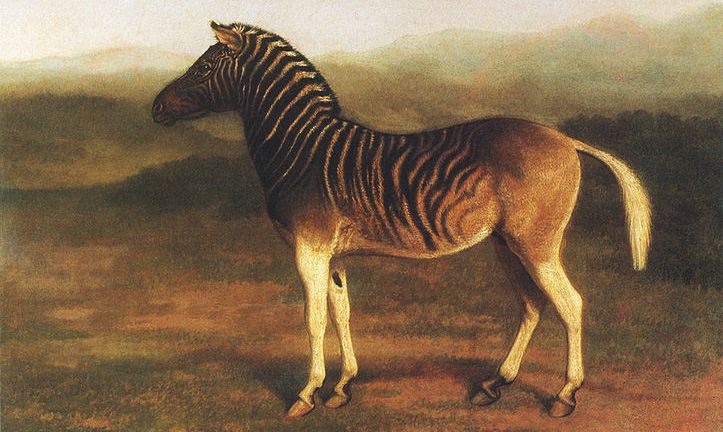The quagga was originally classified as an individual species, Equus quagga, in 1778. Over the other 2000 years or so, many other zebras were described by naturalists and explorers. Because of the great variation in coat patterns (no two zebras are alike), taxonomists were left with a great number of described "species", and no easy way to tell which of these were true species, which were subspecies, and which were simply natural variants.
Long before this confusion was sorted out, the quagga had been hunted to extinction for meat, hides, and to preserve feed for domesticated stock. The last wild quagga was probably shot in the late 1870s, and the last specimen in captivity, a mare, died on August 12, 1883 at the Natura Artis Magistra zoo in Amsterdam. Because of the confusion between different zebra species, particularly among the general public, the quagga had become extinct before it was realized that it may have been a separate species.
The quagga was the first extinct creature to have its DNA studied. Recent genetic research at the Smithsonian Institution has demonstrated that the quagga was, in fact, not a separate species at all, but diverged from the extremely variable plains zebra, Equus burchelli, between 120,000 and 290,000 years ago, and suggests that it should be named Equus burchelli quagga. However, according to the rules of biological nomenclature, where there are two or more alternative names for a single species, the name first used takes priority. As the quagga was described about thirty years earlier than the plains zebra, it appears that the correct terms are E. quagga quagga for the quagga and E. quagga burchelli for the plains zebra, unless "Equus burchelli" is officially declared to be a nomen conservandum.
Quagga specimen in the natural history museum of Milan
After the very close relationship between the quagga and surviving zebras was discovered, the Quagga Project was started by Reinhold Rau (1932–2006) in South Africa to recreate the quagga by selective breeding from plains zebra stock, with the eventual aim of reintroducing them to the wild. This type of selective breeding is also called breeding back. A foal of the Quagga Project, named Henry, was born on 20 January 2005. In early 2006, the third and fourth generation animals produced by the project were reported to look very much like the depictions and preserved specimens of the quagga. The practice of breeding back generally and specifically whether looks alone are enough to declare that this project has truly recreated the original quagga are both controversial.
DNA from mounted specimens was successfully extracted in 1984, but the technology to use recovered DNA for breeding does not exist. In addition to skins such as the one held by the Natural History Museum in London, there are 23 known stuffed and mounted quagga throughout the world. A twenty-fourth specimen was destroyed in Königsberg, Germany (now Kaliningrad), during World War II.
http://en.wikipedia.org/wiki/Quagga

